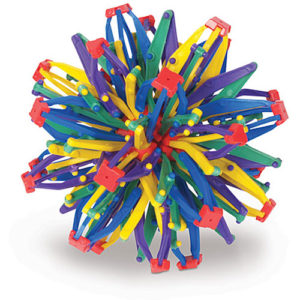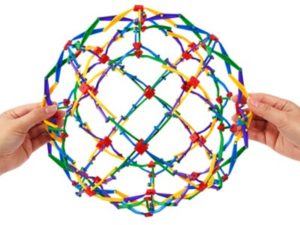Trying too hard is killing your ability to learn and grow. Practicing and experimenting help. But trying too hard – not so much.
Why You Need to Stop Trying So Hard
Our brain floats inside our skull, pictured here as a multi-colored sphere.
But when we try too hard, the sphere gets really really tight, like a fist. When this happens to me, my brain feels all scrunched up. What does it feel like when you think too hard?

Learning often requires expanding our perspective, which is the exact opposite of tightening it. Our brains need space to expand. It’s physics.
The answers we’re trying so hard to find, and the things we’re trying so hard to learn, by squeezing our brains, are sitting somewhere outside our brains, waiting to be found. But we can’t see them because our brains are squeezed tight
The Trying Too Hard Brain in Action
I witnessed the difference between the relaxed open brain and the trying too hard brain, while facilitating practice sessions for experienced coaches seeking advanced training via Marcia Reynold’s Breakthrough Coaching program
One month the coaches were practicing how to identify what was most important for the client to address. Often, without any prompting by the coach, the client stated what was most important at the beginning of the session.
The coaches were trying so hard to get it right, that they didn’t notice the client had answered the question before the coach asked it. The coaches’ brains were too tight. There was no space to see or hear anything other than the question they were thinking about asking. So, the coaches asked the question, even though the the client had just answered it. The clients gave new and different answers. Their most important thing got lost because the coach was trying too hard. This one small miss created a flat, low energy, low value coaching session.
How To Create Space for Your Brain to Learn
Breathe.
Breathing creates space. It’s why pregnant women and their partners take breathing lessons in preparation for child birth. The body’s natural tendency is to tighten around pain. Unfortunately It makes the pain worse. So we have to practice breathing into and around the tightness to create space and relax the area around the pain. Practicing this breathing response makes it available when we need it most, but would be most inclined not to use it.
Instructions for practicing the brain breath
- Sit or stand straight, without being rigid
- Let your shoulders relax back and down
- Hold your head and neck high but not stretched tight
- Take a deep breath in through the nose
- Feel the breath fill your chest as you simultaneously direct it upwards to your throat, face, eyes, forehead, top of your head and back of your head
- On the long slow out breath, feel you head, forehead, face, neck, shoulders and chest relax down
- Rinse and repeat twice more
- Notice the space inside your shoulders, throat, eyes, forehead, top and back of your head
Whenever your brain feels tight, practice breathing space into and around it so you can see more and think better.



